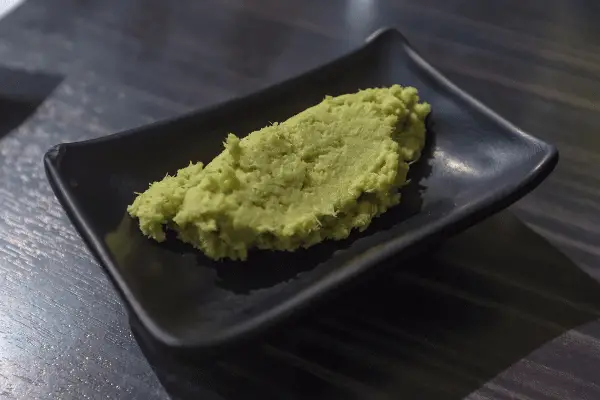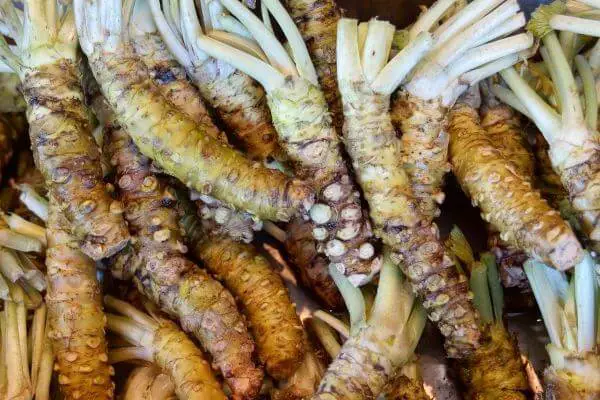Wasabi is a green paste that is served with Japanese dishes, primarily sashimi and sushi, also for soba, an additional kick to taste in the dipping sauce. It can enjoy it with other food that includes spiciness complements like roast beef. Real wasabi tastes green and bright with a touch of rapidly fading heat.
Many people ask what wasabi is made of, looking for detail on wasabi ingredients or a recipe on how to make wasabi at the house. However, the right answer is there is only one ingredient of wasabi, and that’s wasabi. To make wasabi, one has to grate the rhizome of the Wasabia japonica plant, and it quickly becomes wasabi paste, ready for eating. There is no mixing or any other type of preparation involved.
What is real wasabi made of?
True wasabi, or real wasabi, is made from the root of the wasabi Japonica plant, also known as Japanese horseradish, a mustard family plant.
This plant grows in mountain streams in Japan and has been cultivated on a wasabi farm for centuries. Because of its specific growing necessary, its cultivation is limited. The fresh wasabi root is harvested and grated into a paste. The paste can be used fresh, and it can be dried and powdered. The wasabi powder is mixed with water to establish the familiar green condiment that we know and like.
What is fake wasabi made of?
Many wasabi pastes is fake! Fake wasabi is made of cornstarch, mustard, horseradish and green food colouring. Sometimes, mustard is included in the mixture, and very sporadically, a tiny amount of real dried wasabi powder and grated wasabi. It has the same flavour as real wasabi, but it lacks the attributes of spice and heat. So if you are ever consuming sushi and thinking the wasabi was a blend or tasteless, you were consuming fake wasabi.
Difference between fake and real wasabi
Wasabi is widely available in Japanese and Japanese food restaurants. But, if you thought you had tried wasabi before, the chance is that you have not. Several people who consumed only wasabi outside of Japan likely only had imitation or fake wasabi. In Japanese, hon-wasabi refers to the plant of wasabi native to Japan, while seiyo-wasabi is the word for horseradish from Europe.
If you are surprised how to tell the difference between the fake and real wasabi, check the wasabi paste’s texture. If the wasabi is pasty and thick, that is a sign that it is fake wasabi from horseradish. If the consistency is gritty, it is more probably true wasabi from a wasabi plant stem.
Real wasabi is served fresh because it quickly loses its zinginess and flavour once grated. For example, the chefs will carefully grate the required amount of wasabi to complement the sushi and balance the fish flavour at a rich-end sushi restaurant. It is usually placed between the nigiri sushi topping and the rice to preserve it as best as possible.
Why is real wasabi so expensive?
The wasabi is native to Japan and is one of the most expensive crops in the world. The reason is a lot of people outdoor in Japan may have never actually tasted real wasabi before. Real wasabi is extremely expensive because wasabi plants are notably difficult to grow and need very specific conditions.
In Japan, wasabi is naturally grown in places that have mountain river valleys where these wasabi plants can grow along the river stream beds. This perfect growing environment is extremely rare, and wasabi plants require their stems to be partially submerged in running water, including another level of finickiness to the process. Rather than running stream beds in Japan’s mountain river valleys, cultivating wasabi on an economic level is very challenging, thus making it a pricy plant to grow.
Real and fake wasabi may protect against food poisoning again
Like more food pairing, there is the reason why people started consuming ground wasabi with their sushi. Wasabi and horseradish have a compound that may prevent food poisoning. Historians consider that wasabi was originally combined with food during the Edo period because its strong aroma reduced the fishy smell of food.
It became a particularly famous combination with sushi fish because they considered its ability to stop bacteria from growing. Today study has revealed that because of something called allylisothiocyanate, a compound that gets out upon grating wasabi and horseradish.
That is good news because eating raw and undercooked seafood comes with certain health risks, including salmonella, tapeworms and contracting listeria. Wasabi is no cure if you experience less than fresh fish, but it never damages to have a little backup on your side just in case.
What is wasabi sauce made of?
Wasabi sauce is a foreign sauce made from the wasabi plant directly, grown mainly in mountain valley regions of Japan. Wasabi is also named Japanese horseradish. It has an earthy and sharp taste, known to hit the nose instead of the tongue.
When you taste a drop of it, the flavour arises in the nose with a slight tingle and stinging sensation. Wasabi sauce is available in paste and powder, generally green in colour. Wasabi grows only in some locations; the sauce is expensive.
What is wasabi powder made of?

Wasabi powder is a hot tasting powder made from the wasabi plant’s dried, ground root Japonica. Wasabi powder can be eminent of its light lime colouring and hot taste, sharp and aroma.
Many of the powder that it sold internationally is not, in fact, genuine wasabi but instead a mix of horseradish, mustard and colour additives. The reason for this is the rich cost and scarcity of wasabi roots. For the true wasabi lover, there is no alternative to real wasabi root that has been ground into powder.
What is wasabi vegan salmon made of?
The vegan salmon is made by liquefying konjac into a naturally oranged-coloured gel. The product is made from canola, tapioca and flaxseed oil, which mimic the taste and texture of fish.
What are wasabi peas made of?
Wasabi peas are green coloured peas that have been coated and roasted in a mixture of starch, salt, oil, sugar and wasabi. Wasabi peas are an extremely famous snack in their native Japan. They may also have artificial colouring, depending on the brand. Wasabi is a form of horseradish plant grown in Japan. The root is harvested and made into powder and paste for flavouring food.
Nutritional information Wasabi
Although wasabi is low in fat, sugars and calories, it can be rich in sodium, so it’s essential to pay attention to labels when buying this green condiment. The USDA has provided the following nutrition detail for one tablespoon of wasabi paste.
- Fat: 1.7 grams
- Carbohydrates: 7.4 grams
- Sugars: 2.1 grams
- Calories: 47
- Sodium: 542mg
- Fibre: 1 gram
- Protein: 0.4 gram
Fats
Wasabi is low in fat, with only 1.7 grams per tablespoon.
Carbs
Wasabi emanates from a plant in the same family as cruciferous vegetables such as cauliflower, broccoli and cabbage. Therefore it is not curious that many of its calories come from Carbohydrates. Wasabi one tablespoon paste contains just over 7 grams of carbs.
Proteins
Wasabi protein content is also actually low. One tablespoon has less than 1 gram of protein.
Vitamins and minerals
In some wasabi pastes, a micronutrient to stay regardful of is sodium. According to the USDA, one tablespoon of wasabi prepared paste harbours 542 mg of sodium, and about 24% of the American Heart Association’s suggested intake of no more than 2300 mg per day.
If you are on a low sodium diet, wasabi flavour addition may not be benefits the sodium it adds. Wasabi also has trace amounts of other minerals and vitamins, such as zinc, potassium and iron. However, because many people consume a decent amount of wasabi at a time, these micronutrients are not probably to make much difference in your health.
You might be interested : (What are the side effects of consuming wasabi?)
Cultivation of wasabi

The wasabi plant grows wild and streams in the mountains and mountain valleys. Cultivation is challenging even in ideal settings that imitate a stream bank, as the plant requires humid, shady and cool conditions and is prone to disease. The rhizome can take up to 3 years to reach maturity, and any damage to the brittle leaves by animals and farmworkers can slow its growth.
Given the strict environmental requirements, wasabi is grown economically mainly in Japan’s Shizuoka prefecture, specifically in the Izu Peninsula and Nagano and Iwato prefectures. There are a few different styles of wasabi cultivation in Japan, and everyone is associated with different qualities of wasabi rhizomes.
Traditional methods commonly employ few fertilizers and confide on mineral-high spring water and manual labour, making them slightly impact the environment. The fields are carefully engineered with rocks and gravel to copy the plant’s natural habitat and adjust to gentle flooding.
Few have been in continuous production for hundreds of years. Wasabi has been successfully cultivated in Taiwan, Korea, New Zealand, the United States and China, though commonly on a small scale. There has been a finite success with growing the plants in the greenhouse or using hydroponics, and these operations have been costly.
